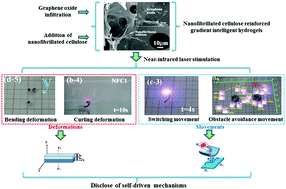Bionic intelligent soft actuators: high-strength gradient intelligent hydrogels with diverse controllable deformations and movements†
Abstract
A series of novel nanofibrillated cellulose (NFC) reinforced gradient intelligent hydrogels with high response rate, multiple response patterns and diversified self-driven functions were successfully prepared. Based on the effect of the hydroxide radical of NFC on the addition reaction, and on the dehydration synthesis, the variation of NFC significantly regulated the gradient structure of the intelligent hydrogels. In addition to the infiltration property of graphene oxide (GO), reinforcement of NFC enhanced the crosslinking density and Young's modulus, which built a relationship between material characteristics and near infrared laser response rate. Intelligent hydrogel actuators realized bending deformation, curling deformation, switching movements and obstacle avoidance movements. The hydrogels with high Young's modulus exhibited relatively low self-driven rates and efficiency. The self-driven mechanisms of NFC reinforced gradient intelligent hydrogels were revealed effectively by constructing the mathematical relationship curvature variation, bending degree, deformation displacement, material characteristics and incentive intensity. The investigation showed a new path for the combination of mechanical property, intelligent property and functional property of intelligent hydrogels in a bionic soft robot and health engineering.

- This article is part of the themed collection: 2020 Journal of Materials Chemistry B most popular articles


 Please wait while we load your content...
Please wait while we load your content...